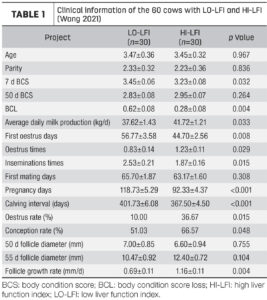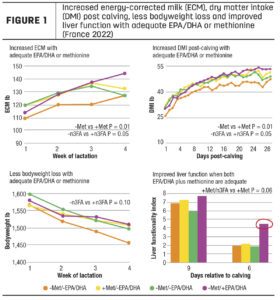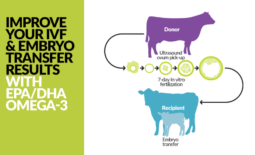Exploring Nutrient Synergies: EPA/DHA Omega-3 and Methionine
As seen in Progressive Dairy
Feeding adequate levels of either methionine or EPA/DHA pre- and post-fresh to dairy cows shows strong improvements in milk production and liver function.
The results from this study showed strong production improvements in response to feeding adequate levels of either methionine or EPA/DHA pre- and post-fresh, plus positive synergistic effects in performance and in improving liver function.
“Just because something is common doesn’t mean it is normal.” This phrase rings too true when it comes to transition dairy cow health. When 30% to 35% of all dairy cows on average are affected by disease in the first three weeks post-calving, the likelihood that a cow will stumble in her start out of the lactation gate is too common and is the reason that so much effort is made at the farm and research levels to find new and better ways to improve management practices and nutritional provisions during this high-risk period. While transition diseases are common in dairy cattle today, it doesn’t mean that this must be our normal in the future. We can do better, and the latest research from Cornell University on the nutrient synergies between methionine and EPA/DHA omega-3 is a great step toward that goal of making disease-free transitions more the norm.
The challenge for transition cows
In her presentation for the American Dairy Science Association (ADSA) in 2022, Tanya France, Ph.D. candidate from the McFadden Lab at Cornell University, explained that transition cows go through tremendous change from pre-calving to post-calving. Dry matter intakes (DMI) are lower, resulting in lower nutrient uptake at a time when milk production is rapidly increasing and driving higher energy demand. This dynamic transition into lactation necessitates that cows have a high degree of metabolic flexibility to meet the energy demands for milk and component synthesis, while maintaining healthy liver function.
The hypothesis
The focus of France’s research is on testing the hypothesis that if cows are lacking adequate levels of both EPA/DHA omega-3 and methionine, their liver function will be impaired, causing an increase in fatty liver and lower production due to less partitioning of fatty acids to the mammary gland. (For the scientists in the audience, France explains that the PEMT pathway that is critical for exporting fatty acids from the liver may be limited by the levels of long-chain fatty acids, such as DHA omega-3, given the evidence that this is true in other species.) This is a research effort focused on exploring nutrient synergies versus simply focusing on one nutrient or the other – a recognition of the “system” that is the cow and the complexity of how nutrients interact to support all the cow’s vital functions.
Methionine is an essential amino acid and the first limiting amino acid for milk production in cows. Rumen protected (RP) methionine has been shown to increase milk production, reduce oxidative stress and improve liver function in the transition period. EPA/DHA omega-3 is an essential nutrient that is fed as a calcium salt to prevent against biohydrogenation in the rumen. These bioactive omega-3s are critical for embryo development and healthy immune function, as they activate the anti-inflammatory response with resolvins and protectins.
The study design
This transition study included four treatments that spanned from three weeks prior to calving through four weeks post-calving. Treatments included: 1) Inadequate levels of both nutrients, 2) adequate methionine and inadequate EPA/DHA 3) inadequate methionine and adequate EPA/DHA and 4) adequate levels of both nutrients. For reference, the diets without RP-methionine were formulated to be deficient in methionine at less than 0.96 gram of methionine per megacalorie (Mcal) of metabolizable energy versus the +RP-methionine treatments that were formulated at greater than 1.13 grams of methionine per Mcal of metabolizable energy. Likewise, the diets without EPA/DHA were fed a calcium salt of palm oil with no omega-3s at 1.5% of dry matter versus the +EPA/DHA treatments that included calcium salt of palm oil with EPA/DHA fed at the same rate (this equates to approximately 0.4 pound pre-fresh and 0.7 pound post-fresh).
Improved ECM and liver function
The results from this study showed strong production improvements in response to feeding adequate levels of either methionine or EPA/DHA pre- and post-fresh, plus positive synergistic effects in performance and in improving liver function. Adding EPA/DHA versus a fat supplement without omega-3s yielded 5.3 pounds more energy-corrected milk (ECM), plus higher milkfat and protein yields (p>0.05). Likewise, feeding adequate versus inadequate levels of methionine also resulted in improved ECM (7 pounds), as well as higher milk protein percent and yields, and milkfat yield as well.
Regarding liver function and metabolic health, cows that were fed adequate levels of both methionine and EPA/DHA omega-3s had enhanced liver function, characterized by increased serum albumin and total protein concentrations. The researchers also saw improvements in the liver functionality index (LFI) when cows received adequate levels of both nutrients, reinforcing the synergistic mechanisms that France hypothesized before the study began. LFI is a practical measure of liver health and likelihood of associated diseases and calculated based on three biomarkers associated with liver function (albumin to measure plasma protein synthesis, cholesterol to measure lipoprotein synthesis, and bilirubin to measure heme catabolism).
The liver holds a key
While the LFI is a relatively new assessment tool, there are several recent studies that help frame up the significance of these findings. LFI values typically range from -12 to 5, with higher LFI scores correlating to better liver function, less inflammation and better metabolic health of the cow. In the France study, the cows with both adequate methionine and EPA/DHA levels had an LFI of over 4 versus the other treatments at 2 LFI. What does that translate to regarding health and performance as a predictive measure?
One study sought to investigate if there was a correlation between LFI and inactive ovaries in the postpartum period, with the intention of assessing LFI as an early monitoring tool to predict inactive ovaries and perhaps intervene earlier for better outcomes (Table 1).
It found that cows with low LFI scores, compared to cows with high LFI scores, had significantly higher numbers of inactive ovaries (36% versus 10% in the group with a higher LFI). In other words, cows were 2.7 times more likely to have inactive ovaries if their LFI was low. The study also found correlations with LFI and other reproductive health measurements, including greater body condition loss, longer days to first estrus and pregnancy, lower heat detection and conception rates, and lower milk production.
Another study focused on evaluating LFI and its association with negative health events, milk yield and risk of pregnancy within 150 days in milk (Figure 1). Strong correlations were found in this study as well, with low LFI cows having greater incidences of transition disorders, including metritis, displaced abomasums, ketosis and a higher incidence of culling in the first 30 days. In multiparous cows, each one-unit increase in LFI correlated with a 7% increase in pregnancy at 150 days in milk.
Points to remember
- Significant gains in ECM with less body condition loss were seen in the first four weeks post-calving when cows were supplemented with adequate levels of RP-methionine or a calcium salt with EPA/DHA omega-3.
- When both nutrients were provided at adequate levels, LFI improved in the first week post-calving.
- Maintaining high liver function is key in improving our ability to transition cows well, as research shows strong correlations between low LFI and all the things we are trying to help her avoid: more transition disorders, greater likelihood of early culling, poor reproduction and lower milk production.
- While feeding RP-methionine is fairly common given the defined nutrient requirements, this research suggests that including EPA/DHA omega-3 in transition diets is a nutrient we’ve perhaps missed that works in synergy with methionine for healthy liver function.









